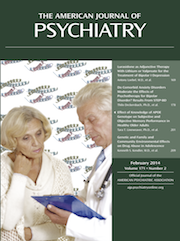In This Issue

Older adults who know they have the ε4 allele of the apolipoprotein E (APOE) gene, a risk factor for Alzheimer’s disease, perform worse on objective tests of verbal memory than do those who do not know they have the allele. Lineweaver et al. (CME, p. Original article: 201) also discovered that knowing whether one does or does not have the allele can diminish or improve, respectively, self-appraisal of memory (figure). In an editorial, Karlawish and Green (p. Original article: 137) point out that such information may disrupt individual well-being and could bias studies of biomarkers for neuropsychiatric disease.
The antipsychotic lurasidone was recently approved for bipolar I depressive episodes. In a 6-week study of moderately depressed outpatients, lurasidone monotherapy demonstrated response rates of 53% for low-dose (20–60 mg/day) and 51% for high-dose (80–120 mg/day) treatment, compared to 30% in the placebo group. Loebel et al. (p. Original article: 160) report that the rates of treatment-emergent mania were 3.7% for low-dose treatment and 1.9% for placebo and high-dose treatment. Nausea and somnolence were common side effects. In another 6-week study of depressed outpatients (p. Original article: 169), lurasidone as an adjunct to lithium or valproate demonstrated a response rate of 57%, compared to 42% for placebo. The mean daily dose of lurasidone was 66.3 mg. In both treatment and placebo groups, lithium and valproate levels were maintained at 0.6–1.2 mEq/L and 50–125 μg/ml, respectively. Treatment-emergent mania occurred in 1.1% of the lurasidone group and 1.2% of the placebo group. Rates of treatment-emergent suicidality were 9% for lurasidone and 6% for placebo. In the monotherapy study, suicidality was 14% in all three groups. Belmaker comments in an editorial (p. Original article: 131) on antipsychotics’ efficacy for bipolar disorder and how this contributes to the unitary psychosis theory.
Adding intensive psychotherapy to medication for depressed patients with bipolar I or II disorder increases the likelihood of recovery in those who also have a lifetime diagnosis of an anxiety disorder. The analysis by Deckersbach et al. (p. Original article: 178) did not show an advantage for depressed bipolar patients without a comorbid anxiety disorder or those with multiple anxiety disorders. Adjunctive intensive psychotherapy is especially effective for generalized anxiety disorder and posttraumatic stress disorder.
Environmental factors, as well as genetics, influence the likelihood of drug abuse, especially in males. Nationwide Swedish registries examined by Kendler et al. (CME, p. Original article: 209) revealed that sharing a household with a drug-abusing sibling increased the probability of drug abuse in another sibling. Living in the same area or city had a similar effect. Drug abuse was also associated with low family socioeconomic status and neighborhood social deprivation. These varied environmental influences, notes editorialist Hopfer (p. Original article: 140), suggest both individual and public approaches to preventing drug abuse.
The chances of developing schizophrenia are higher than average in individuals with autoimmune disorders, and Benros et al. (CME, p. Original article: 218) report that the reverse is also true. In Danish national registries covering people born between 1945 and 2010, the risk of developing autoimmune disease was modestly higher in people with preexisting schizophrenia or related psychosis, and it was more than twice as high in those with a psychotic disorder who were hospitalized for an infection before being diagnosed with an autoimmune disorder.



